Echoing summer’s great arc of planets at dawn, winter presents the full octet again, this time splayed across the evening sky.
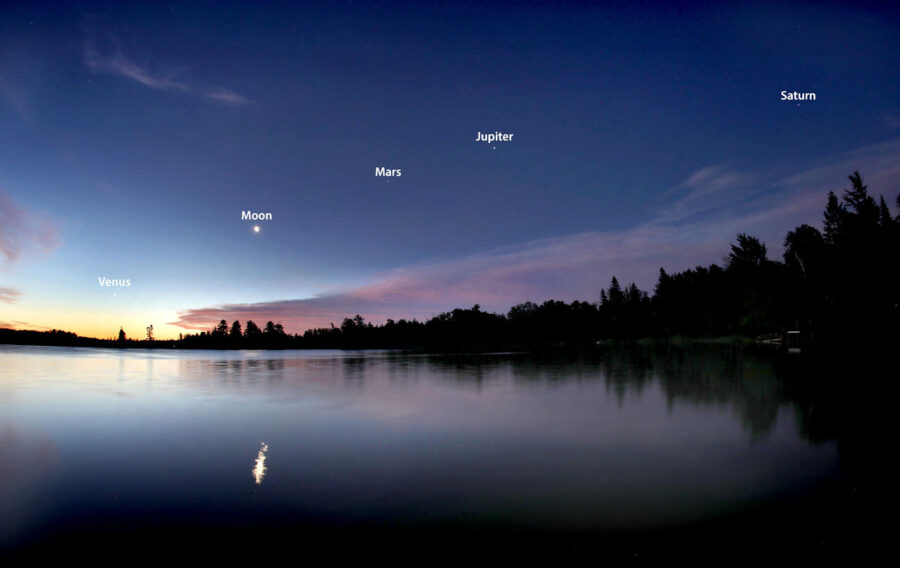
Bob King
There are second chances in astronomy as there are in life. If circumstances prevented you from seeing June's inspiring alignment of all eight planets, you can see them again this month. This time they fan out across the evening sky at dusk and will remain easily visible with the naked eye and binoculars through year's end. While the symmetry of the alignments isn't quite as elegant — they're not sequentially lined up in order of their distance from the Sun — the arrangement is nonetheless satisfying, with all the planets visible at a glance. Starting at the western horizon and moving upward and east, we'll see Venus, Mercury, Saturn, Neptune, Jupiter, Uranus, and Mars in that order.
As before, feel free to add the planet you're standing on to complete the octet. If you'd rather have the Moon substitute for Earth, a willowy crescent glitzes the scene on December 24th, joining Venus and Mercury in a 7°-wide isosceles triangle low in the southwestern sky 25 to 60 minutes after sundown.
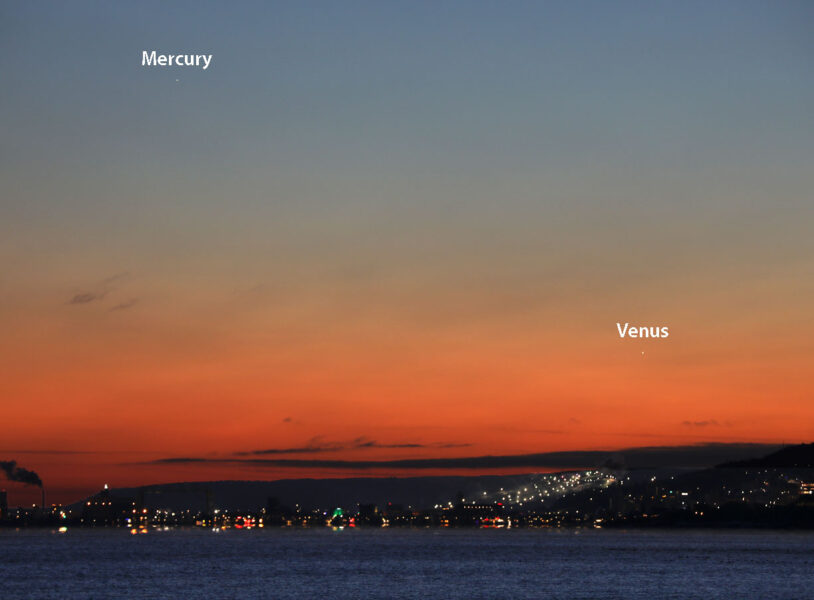
Bob King
On December 18th, I checked the visibility of Venus and Mercury from my snowy outpost here in Duluth, Minnesota. Brighter Venus was obvious in the 8×42's about 15 minutes after sunset, and I could see both with the naked eye (Mercury faintly at magnitude –0.6) some 35 minutes past sundown. For observers living farther south, the view improves somewhat because these twilight-loving worlds meet the horizon at a steeper angle.
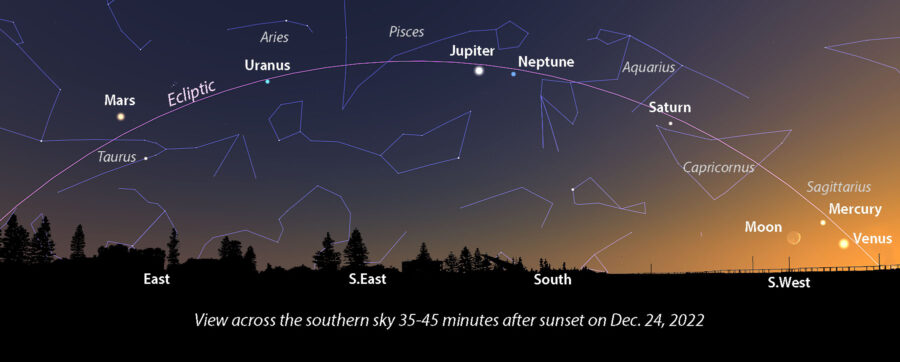
Stellarium with additions by Bob King
Start looking early to catch Mercury and Venus before they're lost in the haze or dip below the horizon. After that you can relax. Saturn shines at magnitude +0.8 about 25° high in eastern Capricornus at nightfall. Once a planet is well past opposition, as in the case of Saturn, we sometimes tend to ignore it. If that's you, this would be an excellent time to set up a telescope and renew your acquaintance before twilight swallows the ringed wonder. The rings are tilted 14.2° with their north face visible. The northern hemisphere and prominent North Equatorial Belt remain in full view, with the bottom third of its southern hemisphere poking out below the ring plane.
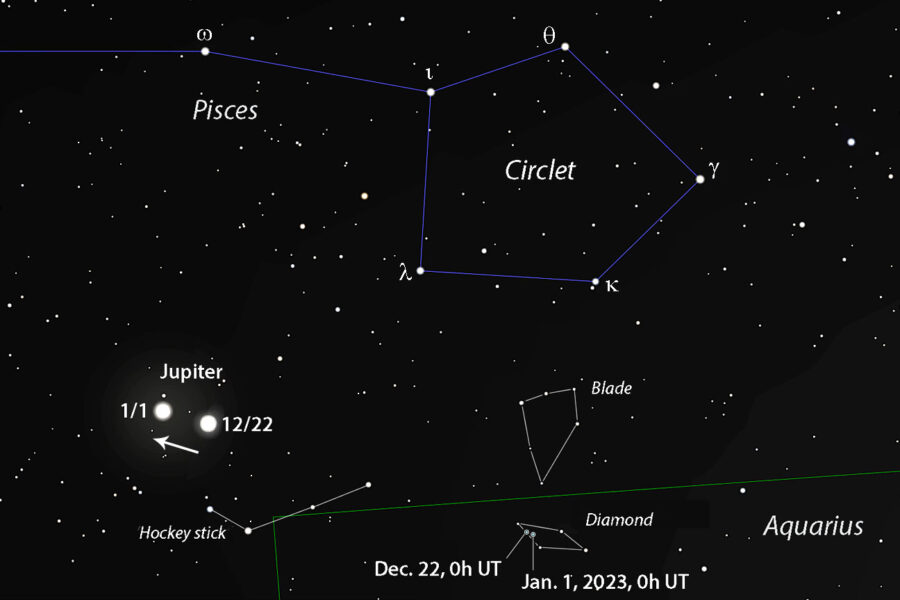
Stellarium with additions by Bob King
East of Saturn we arrive next at Neptune, the faintest planet of the bunch. At magnitude 7.9 you'll need a pair of binoculars to spot it. I've seen it in my 8×42s, but from darker skies I'm sure 7×35s will bag it. The remote ice giant glimmers from eastern Aquarius below the Circlet of Pisces asterism just 7.5° southwest of brilliant Jupiter. In fact, you may want to jump the line and observe Jupiter first so you can use the brighter planet to get an easy ride to Neptune. Jupiter is so enormous that if you scooped out its innards you could stuff it with nearly 1,000 Earths. After Venus it's the brightest planet in the grand arc, gleaming at magnitude –2.4.
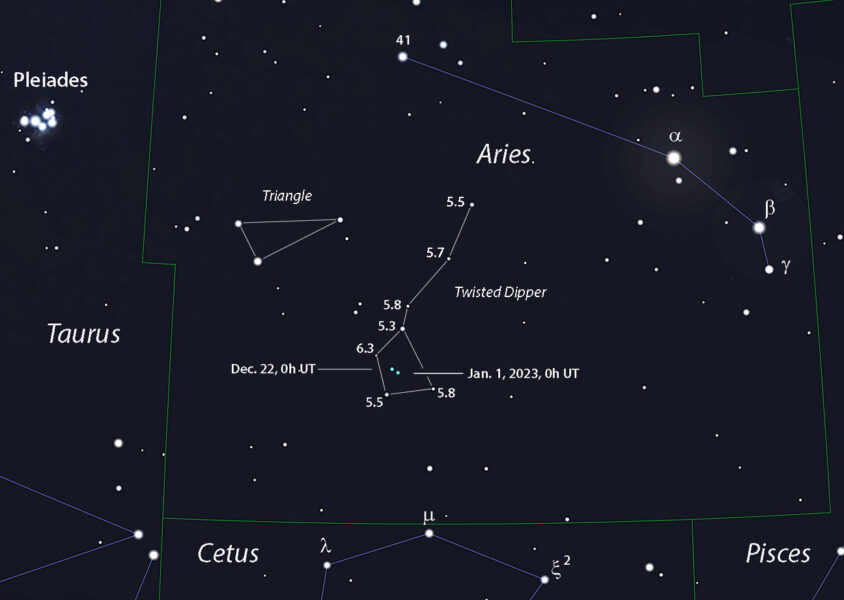
Stellarium with additions by Bob King
Uranus is next in line. Situated 45° east of Jupiter in Aries it looks like a 5.7-magnitude star in binoculars. From a dark sky, challenge yourself to see it with the naked eye around 9 p.m. local time, when the planet transits the meridian and shines highest in the sky. Looking in its direction it's hard to ignore the golden-red glare of Mars in Taurus, the next constellation over. Mars is currently the closest planet to Earth (88 million kilometers) and continues to radiate that special opposition glow. At magnitude –1.5, it's equal in brilliance to Sirius but with its own distinctive color.
On December 21st the seven planets (and Moon) will span 146° arc of sky. That shrinks to 135° by year's end, around the time Mercury departs the scene. Spring's dawn arrangement was tighter — just 91° — on June 3rd. But Mercury was invisible in the solar glare at the time for most observers. On June 24th, which many considered the prettiest morning, the arc had expanded to 107°.
I remember being deeply affected by the sight. The sequential arrangement of planets in a line not only demonstrated the essential flatness of the solar system but also how tiny these orbs are compared to the vastness of space between them. All of us learned these simple fact years ago, but seeing them played out across the sky is quite another thing.
In case of poor weather you'll still be able to enjoy the sight. Italian astronomer Gianluca Masi will livestream the planetary "grand tour" on his Virtual Telescope website starting at 16:00 UT (11 a.m. EST) on December 28 th.
Have a wonderful, planet-packed holiday and toasty solstice! Winter starts today in the Northern Hemisphere at 4:48 p.m. EST.
 4
4









Comments
PGT
December 21, 2022 at 9:41 pm
Wonderful article.
But, sigh, I miss Pluto on the lists.
You must be logged in to post a comment.
Bob KingPost Author
December 22, 2022 at 12:44 am
Thank you, PGT. That's so true. But on the other hand, it would make finding all the planets a much more difficult task!
You must be logged in to post a comment.
Anthony Barreiro
December 23, 2022 at 6:06 pm
Vesta at magnitude 8.3 is only a little fainter than Neptune, and should still be visible through binoculars. It's easy to find within a couple of degrees of Delta and Tau Aquarii. Tonight Vesta forms an equilateral triangle with Delta and Tau2, half a degree south of a sixth magnitude star northeast of Tau.
On Friday December 16 I saw all the major planets -- plus Vesta, all four Galilean moons, and our own Moon -- through 10x42 image-stabilized binoculars. I call that a solar system bingo. Weather and other contingencies have interfered since then.
You must be logged in to post a comment.
Bob KingPost Author
December 24, 2022 at 11:32 pm
Anthony,
Bingo it is! Nice work. I almost included Vesta in the lineup (as I did back in the June post) but kept it all planets this time around in part because the asteroid was fainter than Neptune, although as you note, not by much. Have a great Christmas!
You must be logged in to post a comment.
You must be logged in to post a comment.